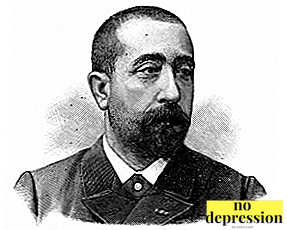Anxiety disorder - a mental disorder in which anxiety comes to the fore and significantly affects the behavior, well-being and personality of a person.
With anxiety disorder symptoms and treatment have a number of specific features and depend on the characteristics of the disease, its form, the individual characteristics of the person and the causes.
Varieties
Anxiety disorder has a large number of forms and often combined with other mental disordersfor example, depression, obsessive-compulsive disorder, panic and phobic disorders.
What is an anxiety disorder? About varieties in this video:
Neurosis
Anxiety disorder has a close relationship with neurosisand many types of disease are forms of neurosis to one degree or another.
Neurosis, or neurotic disorder, is a mental disorder that develops under the influence of chronic stress, conflict and traumatic situations.
With neurosis, the mental activity of a person is disturbed, which causes appearance of characteristic symptoms, such as:
- anxiety;
- concentration problems;
- irritability, aggressiveness;
- mood decline;
- sleep disorders;
- tearfulness;
- reduced stress resistance;
- increased fatigue;
- isolation, indecision;
- panic attacks;
 deterioration of physical condition (headaches, weakness, malfunctions of the gastrointestinal tract, dizziness, loss of appetite, excessive sweating, constant feeling of fatigue, blood pressure jumps, heart problems, especially in people who had cardiovascular diseases and before the appearance of neurosis) ;
deterioration of physical condition (headaches, weakness, malfunctions of the gastrointestinal tract, dizziness, loss of appetite, excessive sweating, constant feeling of fatigue, blood pressure jumps, heart problems, especially in people who had cardiovascular diseases and before the appearance of neurosis) ;- touchiness
Neurosis relate to the most common mental disorders and occur in 10-20% of the population. They are observed in people of all ages, including children, adolescents and the elderly. Every fourth diagnosed mental disorder is a type of neurosis.
Generalized
One of most common types of disease: according to various studies, a violation occurs in 0.1-8.5% of the world's population.
This disorder is also called anxiety neurosis, in which a person has a pronounced, long lasting anxiety, which has no clear connection with recent events in life.
Often combined with other types of mental disorders, due to which the clinical picture may look unclear. People at working age are at risk, but it can also occur at any age, including adolescence and children. In women, the disease is observed twice as often as in men.
Most people with generalized anxiety disorder have been in a severe stressful environment for a long time.
Anxious-phobic

The level of anxiety with this violation is also increased.
People with this disease usually one or more phobias are present - strong irrational fears, which are able to significantly change a person's ideas about reality and change his personality.
People with phobias are forced to look for ways to adapt to their fear: they avoid situations in which it appears, perform rituals designed to prevent its occurrence (for example, constant washing of hands in misophobes).
Anxiety phobic disorder is also called obsessive-phobic neurosis and obsessive neurosis.
Frequent companion of anxiety-phobic disorders - panic attacks.
Symptoms of a panic attack:
- Acute panic attack, fear. This panic is usually associated with phobias that a person has: a misophobe — one who is afraid of germs and dirt — can experience a panic attack if he accidentally takes on a dirty door handle without gloves, an acrophobe — a person who is afraid of heights — feels strong panic during the flight by plane.
- Vegetative symptoms. In addition to feelings of fear, a person experiences somatic (physical) symptoms: he is thrown into fever or cold, his blood pressure rises or falls sharply, and his heart begins to decrease many times faster. Also sweating increases, dizziness, nausea, weakness may occur.
A person with anxiety and phobic disorder may be anxious even in cases when he is not in contact with the object of fear.
Social

This disorder is more commonly known as social phobia. acute irrational fear, which occurs in humans when performing various actions related to social interaction.
Every social phobia fear manifests itself in different ways and may include the following aspects:
- fear of people's views;
- panic fear of public speaking;
- fear of communication with strangers or unfamiliar people;
- fear of being in areas with large crowds of people;
- fear of performing any actions under supervision;
- fear of showing oneself from the best side when communicating with someone;
- fear of blushing during intercourse.
Social anxiety disorder also may be accompanied by panic attacks. A person with a social phobia avoids human society, it is difficult for him to join the team, make friends, a partner, and many professions related to communication are closed to him, which also complicates his life.
Young social phobes are difficult to separate from their parents or cannot separate from them altogether due to difficulties in finding work and are under strong pressure from society, so they often develop depression and other mental disorders, which often leads to attempts to commit suicide.
Social phobia occurs in 1–3% of the population in developed countries and is considered a fairly common disorder. In one way or another, from 3% to 16% of people faced with social phobia.
Organic

The causes of this disorder are organic, that is associated with somatic (physical) diseases.
Diseases that cause organic anxiety disorder:
- Cardiocerebral syndrome. Due to problems in the work of the heart, a sufficient amount of oxygen does not flow to the brain, which causes the appearance of pathological anxiety.
- Various vascular pathologies of the brainwhich also cause chronic oxygen deprivation.
- Hormonal disorders. Expressed problems with hormonal background always lead to the emergence of certain mental abnormalities, since hormones can affect brain function.
- The consequences of traumatic brain injury. Serious traumatic injuries adversely affect the functioning of the brain. In this case, anxiety may appear not immediately after injury, but after a few months or years.
- Hypoglycemia. It is usually observed in people with the first type of diabetes mellitus, in which it is necessary to regularly inject insulin, in cases where the dosage is not correct. Systematic errors in dosage lead to pathological changes in the brain.
Anxiety is not the only symptom of these diseases, but can significantly worsen the quality of life. If it appears, during the treatment of the underlying disease, the doctor prescribes additional medications to the patient that eliminate this symptom.
The development of anxiety can be associated with other abnormalities, such as vitamin B12 deficiency (which is often seen in vegans and vegetarians), side effects of medications, the effect of taking drugs, benign and malignant neoplasms.
Anxiety-depressive

In this violation, two groups of symptoms come to the fore, which associated with anxiety and depression.
This disorder can lead to serious consequences. If you do not start his treatment in time, it can be complicated by other mental disorders.
Most people with this deviation experience panic attacks, mood swings, sleep problems, phobias. Anxiety-depressive disorder often becomes complication of advanced depression or generalized anxiety disorder.
Other species
There are also the following types of violation:
- Mixed anxiety and depressive disorder. In this disease, anxiety and depression manifest themselves equally.
- Doubtful. This type of anxiety is observed with anxiously-suspicious personality type. People with this feature are prone to anxiety, they see danger where it is not there, they often experience it and are touchy.
- Anxiety personality disorderwhich is also called evading disorder- a violation in which people strive to avoid human society for fear of receiving criticism, negative, insults. Such people feel inferior, it is extremely difficult for them to find their place in life.
Also, anxiety anxiety sometimes acts as a symptom of some types of schizophrenia, accompanied by paranoid delusions.
Is anxiety disorder a psychiatric diagnosis? Find out from the video:
Causes of development
The main psychological causes of the violation:
- Chronic stress. It is experienced by people who have stressful work, for example, doctors, fire service workers, miners. Chronic psycho-emotional, physical and mental overstrain, prolonged lack of rest and sleep can also lead to the development of the disease.
- Mental injury. The majority of psychotraumas that can significantly affect mental health are obtained in childhood. The events in which a person received a severe negative experience and experienced a range of negative emotions are considered to be psycho-traumatic. For example, monitoring the dying of a loved one or pet, rape, acute episodes with humiliation, beatings.
- Acute stressful situations: serious problems at work, loss of earnings, illness of a loved one, rupture of relations, radical changes in life.
- Personality Features. Sensitive, suspicious people are more often anxious, prone to developing phobias. Anxiety disorder can appear in them even after reading the heavy informational content: articles, books, films about serious diseases, wars, deaths.
- Vital disorder. People who feel like losers, unable to find work, partner, friends, are vulnerable to various incentives that can trigger pathological anxiety.

Biological causes:
- chronic oxygen starvation of the brain;
- endocrine disorders;
- low blood sugar;
- drug addiction;
- traumatic brain damage, including generic and intrauterine;
- brain tumors;
- side effects of certain drugs;
- regular physical overvoltage;
- excessive sun exposure;
- climate change.
Symptoms and signs
Due to the variety of anxiety disorder, the list of symptoms may be different.
The main symptoms:
- Anxiety, fear. Regular background anxiety is present in all patients. It can be both continuous and periodic. Attacks of fear and panic are not observed in all and depend on the characteristics of the disease.
- Panic attacks. They are also not present in all patients and are not always observed regularly.
- Sleep disturbance Manifest differently, may include insomnia, superficial, light sleep, frequent waking, constant feeling of sleepiness.
- Changes in physical condition. In people with chronic diseases, they are often exacerbated. The work of the cardiovascular system is worsening, weakness, dizziness, nausea, pain in different parts of the body, disruption of the gastrointestinal tract are observed.
- Changes in behavior, reactions. A person becomes more irritable, aggressive, inclined to withdraw into himself, it is difficult for him to interact with the people who surround him. The longer the disease progresses, the more difficult it is to correct changes in the personality of the patient.
- Reduced performance, which is a consequence of impaired cognitive functions, problems with concentration, fatigue.
- Jumping mood, long-term bad mood. Changes in mood occur spontaneously. Elevated mood in a few seconds can turn into anxiety-suspicious, if a person is faced with something that triggered his alarm.
People with anxiety disorder are constantly afraid that something bad will happen to them or their loved ones, avoid everything that scares them.
Psychologist about the symptoms and signs of anxiety disorder:
Treatment
How to get rid anxiety disorder? The basis of the treatment of pathological anxiety is the use of methods of psychotherapy and the use of specially selected drugs.
Pharmacological treatment Anxiety is auxiliary, not major, with the exception of organic anxiety disorder. This is due to the fact that medications only eliminate the symptoms, but do not affect the causes.
Groups of drugs that are used in the treatment of:
 Antidepressants. Despite its name, this group of medicines is not only used to treat depression. Antidepressants improve mood, reduce anxiety, have a positive effect on sleep, appetite. Examples: Imipramine, Amitriptyline, Citalopram.
Antidepressants. Despite its name, this group of medicines is not only used to treat depression. Antidepressants improve mood, reduce anxiety, have a positive effect on sleep, appetite. Examples: Imipramine, Amitriptyline, Citalopram.- Sedatives. Used for mild anxiety disorders. They reduce anxiety, improve sleep, but in case of disturbances of moderate and severe severity are practically useless. Examples: Valerian, Novo-Passit, Persen.
- Benzodiazepines. This group belongs to tranquilizers. These funds are prescribed for phobias, anxiety disorders, obsessive-compulsive disorder. Examples: Clonazepam, Diazepam, Lorazepam.
- Beta blockers. Shown with significant anxiety and the presence of pronounced cardiovascular disorders, triggered by anxiety. Block the action of adrenaline, which is produced when anxiety, fear, therefore, effectively eliminate the autonomic symptoms characteristic of the disorder.
Drug treatment of anxiety disorders in neurotic and neurosis-like conditions is prescribed either before psychotherapeutic treatmentor parallel with it.
In some cases, anxiety disorder can do without heavy artillery in the form of benzodiazepines and antidepressants, but only in cases where the person’s anxiety is mild and the disease is not in a state of neglect.
Also, some psychotherapeutic methods (mainly cognitive-behavioral therapy) allow to achieve positive results and without drug treatment, but only in cases where the disorder is not expressed in severe form, and the patient is ready to fulfill all the prescriptions of the psychotherapist and believes in the success of treatment.
It is extremely difficult to cure anxiety disorder on your own at home., except when it is weakly expressed, it is not burdened by additional mental disabilities, and the person is in a self-help-friendly environment, that is, in cases where he does not have serious life turmoil, and his close circle treats the situation with understanding.
To understand why self-treatment is difficult, you must change the attitude towards mental illness. When a person broke his leg, he goes to the emergency room to get a X-ray and put a cast on it. He does not cure the broken leg at home with herbs and prayers (with rare exceptions).

At the same time, it is widely believed in society that with mental illness can do it yourself in almost all cases, and if a single person cannot do this, then something is wrong with him, for example, he is lazy, or stupid, or pretending.
But this is a completely erroneous opinion, which is often combined with a negative, wary attitude towards psychotherapists and psychiatrists.
In the post-Soviet space, the system of psychotherapeutic assistance to the population is poorly debugged, but even a person without special funds may apply to the mental hospital and get help.
Methods that can help people cope on their own with mild to moderate anxiety disorder:
- Try to sleep enough every day and stabilize your daily routine: it is important to go to bed and get up at the same time.
- Protect yourself from aggressive, unpleasant people. You may need to radically change your life, for example, change your place of work, get a divorce, move.
- It is important to give yourself enough rest. Excessive mental and physical stress can significantly worsen the mental state.
- Медитация, аутотренинг и другие методы релаксации способны положительно повлиять на психическое здоровье.
- Оградите себя от информации, которая способна вызвать приступ паники. К примеру, человеку с со страхом заболеть опасным заболеванием не следует читать статьи о болезнях, смотреть передачи об этом.
- Больше времени посвящайте своим увлечениям, найдите новые.
- Принимайте легкие успокоительные препараты курсом.
Если эти методы не были эффективны, необходимо обратиться к доктору.
Наиболее эффективной психотерапевтической методикой при тревожном расстройстве признана когнитивно-поведенческая психотерапия.
Также при лечении заболевания применяются и другие направления, например гештальт-терапия, арт-терапия, психоанализ. Психотерапевт обучает пациента методам самопомощи и релаксации, меняет отношение к тревоге, дает специальные домашние задания, работает с причинами развития заболевания, помогает решить накопившиеся проблемы.
Перед тем как обращаться к психотерапевтам, важно пройти обследование у кардиолога, эндокринолога, невропатолога, чтобы исключить соматическую природу нарушения.
Прогноз и профилактика

В большинстве случаев прогноз при разных видах тревожного расстройства favorable.
Чем раньше будет начато лечение, тем быстрее наступит выздоровление. Прогноз неблагоприятен лишь в тех случаях, когда заболевание находится в запущенном состоянии.
Чтобы избежать развития тревожного расстройства, следует:
- регулярно заниматься физкультурой и гулять на свежем воздухе;
- достаточно спать;
- чаще общаться с доброжелательными людьми;
- найти хобби;
- избегать стрессовых ситуаций.
Эти рекомендации не исключат вероятность появления тревожного расстройства, но значительно ее снизят.
Если же тревожность появилась, важно начать искать пути ее устранения, чтобы она не стала причиной развития серьезных отклонений.
Врач о антидепрессантах и нейролептиках при тревожном расстройстве:

 deterioration of physical condition (headaches, weakness, malfunctions of the gastrointestinal tract, dizziness, loss of appetite, excessive sweating, constant feeling of fatigue, blood pressure jumps, heart problems, especially in people who had cardiovascular diseases and before the appearance of neurosis) ;
deterioration of physical condition (headaches, weakness, malfunctions of the gastrointestinal tract, dizziness, loss of appetite, excessive sweating, constant feeling of fatigue, blood pressure jumps, heart problems, especially in people who had cardiovascular diseases and before the appearance of neurosis) ; Antidepressants. Despite its name, this group of medicines is not only used to treat depression. Antidepressants improve mood, reduce anxiety, have a positive effect on sleep, appetite. Examples: Imipramine, Amitriptyline, Citalopram.
Antidepressants. Despite its name, this group of medicines is not only used to treat depression. Antidepressants improve mood, reduce anxiety, have a positive effect on sleep, appetite. Examples: Imipramine, Amitriptyline, Citalopram.

